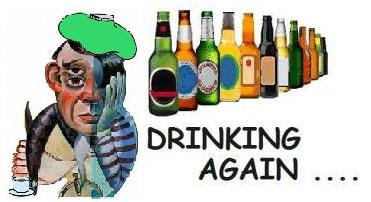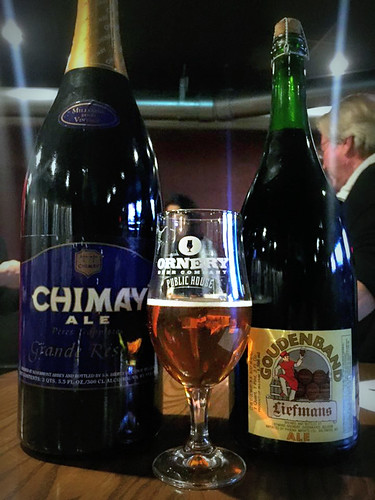UPDATE
The only Trappist brewery in the U.S. is closing (and IPAs are to blame)
— America: The Jesuit Review
23 May 2022
***************
Holy beer, America! There's breaking Trappist beer news. There are now TEN officially-recognized Trappist monastery-breweries in the world, and ...
... according to Belgian Beer Specialist, the United States, on Tuesday, 10 December 2013, became home to one of them —in fact, the first and only in the U.S. —St. Joseph’s Abbey, in Spencer, Massachusetts, fifty-eight miles west of Boston, where the monks have begun brewing Spencer Trappist Ale.
Monasteries of the Roman Catholic Trappist order self-support by producing goods such as cheese, breads, preserves, and, in a centuries-old tradition, beer. For much of the latter 20th-century, the last was rare: there were only six such Trappist brewing monasteries, world-wide: Chimay, Orval, Rochefort, Westmalle, Westvleteren, and La Trappe. And, not really world-wide, but Beneluxian: the first five in Belgium, the last in the Netherlands.

The Trappist brothers at the Belgian
Abbey of Saint Benedict took up the mashing fork, in 1998, with their beer
Achel, while the brothers at
Onze Lieve Vrouw van Koningshoeven were intermittently immersed in hot Holy Water over whether they actually controlled the brewing operations of
La Trappe. All was forgiven in 2005. (UPDATE:
Achel was declassified as Trappist beer in 2023, after the
abbey was closed.)
Westvleteren has been considered the rarest of the Trappist brews. And, for several years, a '
quadrupel' from
Rochefort has been crowd-anointed on
BeerAdvocate.com as the
best beer in the world. Or was it
Westvleteren? It depends on whom you ask. The monks themselves remain silent.
What exactly is a Trappist beer?
Here, from the
International Trappist Association:
Even before Word War II, Trappists were trying to protect the name of "Trappist beer". The monks of Orval were quite conscientious in taking the interests of the Trappists to heart by hiring a lawyer and instituting legal proceedings. Since the name “Trappist” referred to the origin of the product, any businesses which subsequently and unjustly made use of the name “Trappist” or “Trappist Beer” could be sued for dishonest business practices. On September 6, 1985, the Commercial Court in Brussels made it even more explicit: “It is now common knowledge that customers attribute special standards of quality to products made by monastic communities, and this is especially true of Trappist monasteries."
[In 1997,] the International Trappist Association (ITA) was established and the “Authentic Trappist Product” label was created to ensure the consumer of the origin and authenticity of these products, especially in the beer market where a considerable number of brands portray themselves using a “religious” image even though the products don’t come from a monastery.
Our label guarantees the monastic origin of the products as well as the fact that they measure up to the quality and traditional standards rooted in the monastic life of a real Trappist community. Even though this label can be used on other products, at present it is only used on beer, liqueur, cheese, bread, biscuits and chocolates.
The Taste of a Trappist
I suppose a Trappist monastery-brewery could brew an international-style light lager, and, if the brewery were indeed Trappist-approved, that beer would be a Trappist beer. But, thank God, none do that.
Generally speaking, the Trappist monks brew their beers with a distinctive yeast character (spicy, fruity, phenolic), with extra ingredients, such as
candi sugar (disdained by the
Reinheitsgebot, the
German Beer Purity Law), high in alcohol (even though that's not always the case), and in appellations often referred to as
Singel,
Dubbel,
Tripel, and
Quadrupel. These designations are ordinal numbers, indicating a ranking in order of alcohol content, from less than 6% to more than 10% (by-volume). They are not cardinal numbers: they do not imply double, triple, or quadruple anything. (And, then, there's
Orval, sui generis even for Trappist beers: hop-dry and brettanomyces-tangy.)
The newest members of that ten brewing-monastery club
Number eight was
Stift Engelszell, an abbey in Austria, which, last year, became the first Trappist monastery outside of both Belgium or the Netherlands to receive imprimatur for its beer.
And, this past Tuesday, 10 December 2013, numbers nine and ten were admitted. The Trappist
Abbey Maria Toevlucht, in the Netherlands, producing
Zundert and ...
....
St. Joseph’s Abbey, the first, and only (it bears repeating) Trappist monastery brewery in the United States. The monks in Spencer, Massachusetts, have been well-known for their preserves. Now, they are preserving barley malt in liquid form:
Spencer Trappist Ale.
These changes are so new that the
International Trappist Association has yet to list them on its website. But, then again, maybe the ITA doesn't update religiously. It was Baltimore, Maryland-based, blogger Chuck Cook who reported the news: at
Belgian Beer Specialist about
St. Joseph's and on Twitter (
@BelgianBeer1) about
Zundert.
The label [of Spencer Trappist Ale] proudly states “American Trappist” and “Pair with Family and Friends.” The beer is blond with 6.5% abv. Also of note is that the label states the beer contains 11.2 fluid U.S. ounces, or 33 cl of beer, which is the same size used by most of the Trappist breweries in Europe, rather than the 12 fluid ounce/355 ml size that is most common here in the U.S.
For Americans, it might just be a quicker jaunt to Massachusetts than to Belgium. Hello, Trappist! Hello, Spencer!
-----more-----




















